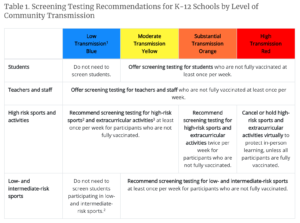As schools across the United States were getting ready to open for the 2021/22 school year back in early August, the Centers for Disease Control and and Prevention (CDC) released guidance for COVID-19 prevention in K-12 schools.
Recognizing that multiple layers of protection were needed to prevent the spread of COVID-19 and keep schools safe, the CDC guidance included the following screening testing recommendations, essentially recommending that the higher the transmission rate within a school setting, the higher the need for rapid asymptomatic testing:
Schools in Ontario opened several weeks later than in the United States. Many parents, politicians, and experts have been advocating for rapid antigen testing in schools to be part of the layers of protection against COVID-19 here in Ontario.
As CBC reported on September 28, 2021, Sam Kaufman, a Toronto parent of an 8-year-old Toronto student, founded a grassroots rapid testing program at his son’s school, finding an Ontario supplier, driving hundreds of kilometres to pick up the kits multiple times a month and spreading the news by word of mouth. “I don’t understand why we wouldn’t use every tool we have to try to keep COVID out of our schools,” Kaufman said.
We need rapid testing across the province, smaller class sizes, better masks, outdoor eating, and HEPA units in all boards. Our government continues to fail our kids and continues to prioritize savings over science. #UnsafeOctober2021 #onted #TestAllKids
— Kate (@DrKateTO) October 6, 2021
Dr. Isaac Bogoch, an infectious disease specialist with Toronto’s University Health Network, has been one of many experts who believes that rapid testing can play an important role in making indoor spaces such as schools safer. “They’re really there to answer the question: ‘Am I contagious with the virus right now?‘” Bogoch said. “Of course, they’re not perfect, but they’re pretty good at doing it and if they were distributed among families, I think we could do a lot of good with those tests.”
Biostatistician Ryan Imgrund has also been advocating for the use of rapid testing in schools, recently sharing this data analysis of COVID-19 cases in Ontario’s schools and comparing per capita case counts in schools to their surrounding communities:
3 Ontario schools with 19 or more cases.
Statistically impossible to have this without massive school transmission. pic.twitter.com/6s0qMKPmsS
— Generative AI (@GenArtInt) October 7, 2021
NDP Education Critic Marit Stiles has been calling for comprehensive rapid testing in schools since early September. Ontario Green Party Leader Mike Schreiner issued the following comment in a press release in early October, “Almost one in every five schools across the province has COVID cases, and the recent Science Table modelling clearly shows that cases in children are increasing. Where are the rapid tests? Where are the lower class sizes? Where is the commitment to keeping our kids safe and schools open?” Liberal Leader Steven Del Duca was quoted as saying, “I am urging Doug Ford to step up to the plate and to do the right thing and to significantly deploy the rapid tests that are available here in Ontario.” in a National Observer article on September 29, 2021.
NDP Education critic Marit Stiles renews call for rapid testing
From @maritstiles https://t.co/3cPeE0e1DT
— Ontario NDP Press Office (@ONDPPressOffice) September 28, 2021
And yet, up until very recently, Premier Ford’s government and Ontario’s chief medical officer of health Kieran Moore had resisted implementing rapid testing programs in publicly funded schools, saying that widespread asymptomatic surveillance testing in schools was not an effective tool.
However, leading up to the Thanksgiving weekend, CTV covered Kieran Moore’s announcement that rapid antigen tests would start to be sent to Ontario schools that were at the highest risk of closure due to COVID-19 spread. Moore said that after reviewing data over the last couple of weeks, his thinking had evolved to see value in asymptomatic testing for unvaccinated students and, as such, local public health units would be given the green light to deploy rapid antigen test kits to schools assessed as “high-risk”. A “high-risk” school can be identified as such either because of ongoing detection of cases, an outbreak, the prevalence of COVID-19 in the surrounding community, or a combination of all three.
We will be following how the province’s new approach to rapid antigen testing in schools unfolds, and also wondering why this layer of protection took so long to be introduced and also wondering if only introducing rapid testing to high-risk schools is sufficient.

